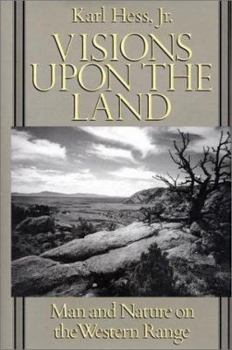Visions Upon the Land: Man and Nature on the Western Range
Visions Upon the Land applies the ideas of democracy and free markets to the management of Western rangelands. This description may be from another edition of this product.
Format:Hardcover
Language:English
ISBN:155963183X
ISBN13:9781559631839
Release Date:August 1992
Publisher:Island Press
Length:312 Pages
Weight:1.30 lbs.
Dimensions:1.1" x 6.0" x 9.0"
Customer Reviews
2 ratings
A Voice in the Wilderness
Published by Thriftbooks.com User , 24 years ago
Karl Hess earned his college degrees, including a Ph.D., in ecology, economics and history. He worked in North Africa on a range rehabilitation project for two years, then spent 5 years working for the New Mexico Department of Agriculture. He also taught graduate courses in public land policy at New Mexico State University. He brings learning, experience, and expertise to the subject of the western range and its management. But more importantly, he brings a deep respect for the men and women who settled the West, and for their descendants who are now being squeezed out of their heritage by their own government. The issues of western range management are complex; Karl Hess explains how rangelands have been mismanaged in the past, and how they are being mismanaged today by those charged with restoring them to a healthy condition, specifically the BLM and the U.S. Forest Service. Visions Upon the Land traces the history of the arid West -- that part of the country west of the 100th meridian -- from the Civil War through the rapid expansion of the 1870's and 1880's, and up to the reforms of the 1930's, particularly the Taylor Grazing Act of 1934. Left to themselves, cattlemen take good care of rangelands, Hess believes. Common sense tells them not to overgraze. There are numerous examples of ranchers' wise stewardship of the land, including the large ranches in Pahrump Valley before WWII. However, two things happened that the cattlemen could not control. One was the introduction of sheep onto the common range, the other was the arrival of settlers under the Homestead Act. Severe overgrazing was the tragic result of too many people and too many animals on too little land. The Taylor Grazing Act was not a universal remedy, but it reversed the trend of overgrazing by issuing grazing permits and leases to stockmen throughout the West. One government report stated that for the period from 1936 to 1966 "the amount of range considered to be in poor or bad condition was estimated to have declined from 58% to 33% in 1966. At the same time, the amount of fair condition range increased from 26% to 49%." Then, the 1970's brought an era of unbridled growth in government. The BLM underwent bureaucracy building that increased its budget many times over. The Bureau became insulated from responsibility for its actions, and took on an attitude of hostility toward ranchers and other "encroachers" on public lands. Hess charactarizes that attitude: "Humans are intruders to be feared, regulated, and held at bay for the sake of preserving the naturalness that remains." So what does the future hold for the western range? Karl Hess sees a continuation of the bureaucratic dictatorship the BLM holds over the land. Nonetheless, Visions Upon the Land argues for a solution that is based on the ultimate American ideal -- democracy. Hess wants to give private citizens property rights in the v
Well Documented history of the Western Range
Published by Thriftbooks.com User , 25 years ago
While i found the middle of the book somewhat slow (he used too much detail to reinforce his main points), the ending chapters are great. He makes a convincing case for local control over the range by people with a vested interest in the land, and against large scale technocratic solutions.






